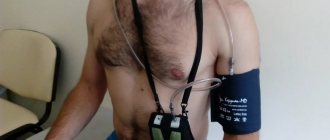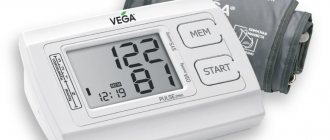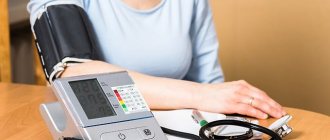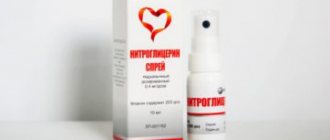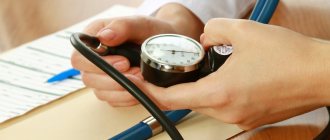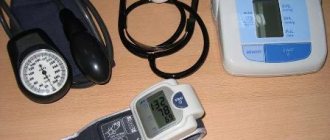Smartphone application
Now you can use specially created software for mobile devices as a diary for hypertensive patients.
The most popular is the special ICare application - the program can be used both as a diary and as an activity tracker, as well as a clear, step-by-step guide to some exercises. As diary entries, it makes sense to keep records, for example, of glucose and temperature, and in automatic mode, through the use of a camera, you can measure blood pressure, pulse, PWV and some other physiological constants. So, thanks to scientific and technological progress, monitoring key biometric indicators has become much easier and more accessible. But it would be very good to measure blood pressure some time immediately after taking the antihypertensive effect of drugs, especially since now there is an excellent opportunity to control, enter and monitor indicators online.
A table for measuring blood pressure is the most important element in the management tactics of any hypertensive patient, and a responsible attitude towards one’s health is the basis for stabilizing hypertension.
How to fill out a diary correctly
First of all, you need to buy or, alternatively, print a sample diary by finding it on the World Wide Web. Templates may differ slightly in the presence of certain additional columns. The table can only record systolic and diastolic pressure readings
For older people and those with concomitant diseases, it is also important to consider under what circumstances blood pressure surges are more likely to occur. The results of the examination are also entered into the diary; diabetics record sugar levels
To correctly fill out a hypertension diary, you need to follow simple but at the same time necessary rules. On the title page you need to fill in the basic information of the diary owner:
In the medication column, if present, it is noted which medications the patient is taking with a mandatory indication of the dosage. To obtain accurate, reliable data, measurements must be carried out 2-3 times in a row at short intervals. During the procedure, it is necessary to ensure comfortable conditions, and the person should move as little as possible and try not to talk.
If the results of the measurements obtained over a short period of time differ greatly, the monitoring should be repeated, and the data of the latest measurements should be entered into the table. Blood pressure should be assessed at least twice daily. The first one is in the morning 15-20 minutes after waking up, the second one is 30-40 minutes before bedtime.
If necessary, blood pressure is also measured during the day and this information is entered into the patient’s diary with a mandatory note about the time of measurements. This is necessary for self-monitoring of blood pressure.
But you also need to remember the following:
Many of our readers actively use a well-known method based on natural ingredients, discovered by Elena Malysheva, to TREAT HYPERTENSION. We recommend that you check it out. Read more.
- keep a diary without gaps;
- the absence of recordings more than 2 times a week invalidates previously obtained measurements;
- It is necessary to take measurements at the beginning of each season, especially for weather-sensitive people.
Just keeping a diary is not enough, you need to sum it up at the end of each month. This way the average value is derived.
The completed diary must be taken to each appointment with your doctor. Based on the recorded indicators, the treatment regimen is adjusted and the necessary additional examinations are prescribed.
Everyone who has been diagnosed with hypertension, even at the initial stage, is required to keep a blood pressure diary. The values of morning and evening blood pressure are recorded there.
Scientists have proven that the patient’s involvement in the treatment process significantly increases his interest in recovery and helps improve the body’s condition.
Arterial hypertension is a disease that requires constant monitoring. To maintain normal blood pressure readings, daily measurements must be taken periodically. This is difficult to achieve in a hospital setting, so experts are increasingly advocating home control of blood pressure surges.
Pressure is a variable value even in a healthy person; it is impossible to assess the patient’s condition using single measurements. Considering the duration of observation, the measurement results must be recorded in a personal diary in the form of a table. Records will be needed to visit a cardiologist. They will help make the correct diagnosis and prescribe the most appropriate treatment.
Templates
The blood pressure diary is a table with the following columns:
- date of;
- time;
- blood pressure readings;
- heart rate;
- description of well-being.
Examples of table design are presented in two versions.
Now hypertension can be cured by restoring blood vessels.
Option number 1. Diary template for working people
If a person, due to his busy schedule, measures his blood pressure only twice a day (morning and evening), the following table will suit him:
| Morning | Evening | Statement of well-being | |
| HELL | Pulse | HELL | Pulse |
| 01.01.20… | / | / | |
In this case, tonometry is performed at a certain time, for example, 20 minutes after waking up and before going to bed.
General information about the blood pressure diary
For a person with arterial hypertension, high blood pressure is no longer just a disease, but a certain way of life
Certain restrictions arise; it is important for the patient to get used to a new way of life, which must be adhered to throughout his life.
Hypertension requires constant monitoring, since fluctuations in blood pressure affect the course of the disease, general condition and treatment methods.
It is best to record regular blood pressure measurements to monitor changes yourself. When visiting the attending physician, the patient must be shown the changes occurring so that the doctor can observe the dynamics of the disease. There is a blood pressure diary for these purposes. It can be on paper or in the form of a spreadsheet. The main thing is that there is constant access to it, and the entered measurements are not lost.
In a day hospital, it is almost impossible to monitor fluctuations in blood pressure, and hypertension only during an exacerbation or during the development of a hypertensive crisis requires hospitalization. In order for the attending physician to select the optimal treatment regimen, he needs blood pressure readings at different periods of time under different circumstances over the past month. A table in which all measurements are recorded will help to collect this information.
It is impossible to assess an objective picture of the patient’s general condition from one-time measurements. A person suffering from high blood pressure should have a blood pressure monitor at home. This is as necessary a device as household items.
It is impossible to remember how blood pressure values changed during the day, let alone several days, so keeping a special diary is simply necessary.
The pressure will return to normal! Just remember once a day.
Filling out the table will not only help to carry out self-monitoring, but will also give the doctor the opportunity to select the optimal therapy in accordance with the presence and nature of pressure fluctuations over time.
Very often, hypertension occurs without symptoms, and at the initial stage it is not noticeable at all; a control diary will help to recognize the disease before it leads to serious complications and consequences. If hypertension is diagnosed, taking into account changes in blood pressure allows you to prescribe the correct treatment, as well as monitor its effectiveness and, if necessary, promptly change treatment tactics.
What is a diary
Blood pressure is measured in the doctor's office. But the problem is that you cannot focus only on a single measurement. Sometimes patients experience elevated numbers during a visit to a specialist, which is explained by the “white coat” symptom.
Considering the increasing rate of detection of hypertension, it is recommended that everyone have a blood pressure measuring device at home.
The indicators are especially important for people who already have health problems. They must measure blood pressure up to three times a day. Naturally, it is simply impossible to remember the data, which is why doctors prescribe patients to keep a control diary. It is used to record data relating not only to tonometer indicators, but also to describe how you feel, as well as other circumstances. Of course, filling out a diary without a tonometer simply won’t work. Therefore, first of all, you need to purchase a device.
Instruments for measuring pressure are mechanical and automatic
There are mechanical and automatic blood pressure monitors. To use the first one, you need to have some experience, but the second one is much more convenient to measure pressure. It is recommended to visit a doctor for the first time and take measurements under his supervision. The specialist will tell you whether you are performing this process correctly and explain how to properly keep a blood pressure diary.
Keeping a diary is necessary not only for the patient himself to assess his well-being, but also for the doctor. A specialist in the dynamics of changes will be able to determine the severity of the pathology and the rate of its progression. If there is no pathology, but during stress or after physical exertion your blood pressure rises, it is recommended to keep a diary. But for people with already diagnosed pathology, accompanied by changes in blood pressure, this self-monitoring is mandatory.
Patients diagnosed with hypertension should regularly check their blood pressure levels
Sample of filling out a diary
The diary must contain the dates and hour marks during which the pulse and blood pressure were measured. If a person suffers from diabetes, it is advisable to add an item in the diary about the results of measuring blood sugar levels. You can download a blank form, get it from your doctor, or draw it yourself in a notebook. If you have constant access to a computer, you can create a table in Excel and record all readings in it.
An example standard table looks like this:
| date | Time | Arterial pressure | Pulse | Well-being | Note (name of medications taken) |
| October 18, 2017 | 8.40 a.m. | 115/70 | 74 | normal | — |
| October 18, 2017 | 19.50 h. | 120/75 | 82 | headache | 1 tablet “No-spa” |
Example of a self-monitoring diary in Excel
If you have constant access to a computer, then filling out the diary can be slightly automated using Excel. For myself, I chose the first option of the self-monitoring diary, inserted a button into it to add readings, which opens a form with the date and time automatically filled in. If necessary, of course, they can be edited both in the form itself and after recording on the worksheet.
It is convenient to move around the form while recording readings using the “Tab” or “Enter” keys. During the transition, the “Well-being” cell is skipped, since in most cases it is not filled in, but if necessary, you can select a value from the proposed options or write down your own. When you click the "OK" button, the readings are recorded in the table and the workbook is automatically saved.
In the “Note” column, you can write down medications taken and their dosage, body weight, if it is monitored, and note visits to the doctor.
Rules for filling out the diary
To keep a diary, first of all, the patient must obtain a special form. It can be downloaded on the Internet or redrawn on a sheet of paper using a standard template. The records will really be useful if you follow a number of simple rules:
- The first step is to fill out the initial page of the diary. On it you must write the owner's full name, age, weight, height and phone number. All this information may be required by the attending physician if he takes the patient's diary for detailed study;
- If there is a “Medicines” column in the blood pressure control diary, it must be filled out. This includes absolutely all medications that the patient takes. Also, do not forget to indicate the dosage of the medicine and the duration of its use;
- Blood pressure should be measured at the intervals indicated in the diary. Missing measurements should not be allowed. Otherwise, it will not be possible to track the correct dynamics of the disease. During the procedure, you should avoid talking and try not to move. Only in this case can an accurate pressure measurement result be achieved;
- If the values of 2 and 3 measurements differ by 10 or more units, then the procedure should be repeated. The last result will need to be entered in the diary, since it is considered the most accurate;
- The first measurement is taken in the morning approximately 20 minutes after getting out of bed. The second time the pressure is measured an hour before bedtime;
- To ensure that the pressure measurement is correct, it is advisable to take a couple more measurements throughout the day and enter them in the self-monitoring diary;
- The diary is filled out every day. If there are 2 or more omissions in it, then the doctor will not take these entries into account when making a prognosis for the course of the disease;
- At the end of the month, it is necessary to summarize all entries made in the diary during this period. The average value of the lower and upper blood pressure must be calculated.
The completed diary, with the help of which the patient monitors blood pressure, should be taken with him to his appointment with the cardiologist.
How to create a blood pressure control diary?
When is the best time to measure blood pressure?
The pressure is measured twice a day, morning and evening, in a calm state, preferably lying down, and always on both arms in turn. The legs do not cross.
The pressure must be measured three times in a row, and then the average value must be recorded. The fact is that in many hypertensive patients, who are usually highly susceptible to stress, the pressure may rise immediately before it is measured - due to the fear that it is elevated. Often the value of the last measurement is significantly lower than the first. Therefore, there is no need to be nervous and stress yourself out. Try to relax and stay positive.
A 12-hour interval is required between measurements in accordance with your daily routine. The independent work carried out by the patient is highly valued by the doctor. The doctor sees that the person cares about his health. This means that you are allies and will definitely achieve a good result.
There are three stages of hypertension. The first (mild) – when blood pressure fluctuates between 140–159/90–99 mm Hg. Art.). The second (moderate) – when the readings on the tonometer are 160–179/100–109 mm Hg. Art. The third (severe) – when the pressure is regularly recorded at 180/110 mm Hg. Art. and higher.
You need to measure your blood pressure before lunch and in the evening, recording the results in a journal. If the condition worsens, then intermediate measurements are taken at any time of the day and the results are entered into a table. To collect reliable readings that will help adjust treatment, follow the recommendations:
- It is better to take the first measurement in the morning, an hour after waking up;
- before the procedure, you should not shower, smoke, drink tea or coffee;
- repeated measurements are taken in the evening and, if there are indications, then at lunchtime;
- The results obtained during periods of poor health are indicative.
People who suffer from hypertension are recommended to take 2-3 measurements during the day. For healthy people, it is enough to carry out two-week tracking of systolic and diastolic boundaries once every 6 months.
How to keep a blood pressure diary
This notebook can be kept in several ways. At the very beginning, the patient’s data must be indicated - weight, age and full name. You can also enter other personal information.
The most convenient way to enter results is a table. You can format and fill it out in various ways. You can simply divide it into several columns into which all the necessary data will be entered. If an elderly person has other chronic diseases, then a complete picture of well-being must be described. Some patients also make notes in their diaries based on meal times.
For those who have a busy work schedule or simply periodically record statistical data, it is not necessary to provide a complete picture of their well-being. Here, the most important thing for the doctor is that all blood pressure values for a certain period are noted.
Examples of diary tables
The table that should be contained in the diary of self-monitoring of blood pressure levels can be of any form. The patient has the right to compose it in the way that is convenient for him. The main thing is that it contains the lines necessary to enter all the important information about the state of pressure. If a person does not know how to create a table, he can consult his cardiologist about this. The doctor will provide the patient with a template that, in his opinion, is most successful.
The table can be kept in a regular notebook. However, today many patients prefer more modern options, which involve the use of special computer programs. It is convenient to make such records in Googledoc or Excel. These programs save important information and carry out necessary operations that are specified by the user. In addition, pressure monitoring diaries in this form can be sent to a doctor without necessarily making an appointment with him.
Below are good table templates for a diary.
Source https://gipertoniya.guru/izmerenie/dnevnik-kontrolya-arterialnogo-davleniya/
Everyone who has been diagnosed with hypertension, even at the initial stage, is required to keep a blood pressure diary. The values of morning and evening blood pressure are recorded there.
Scientists have proven that the patient’s involvement in the treatment process significantly increases his interest in recovery and helps improve the body’s condition.
Arterial hypertension is a disease that requires constant monitoring. To maintain normal blood pressure readings, daily measurements must be taken periodically. This is difficult to achieve in a hospital setting, so experts are increasingly advocating home control of blood pressure surges.
Pressure is a variable value even in a healthy person; it is impossible to assess the patient’s condition using single measurements. Considering the duration of observation, the measurement results must be recorded in a personal diary in the form of a table. Records will be needed to visit a cardiologist. They will help make the correct diagnosis and prescribe the most appropriate treatment.
What hypertensive patients need to know
In order to adequately assess their physical condition, patients with arterial hypertension need to know normal and high blood pressure values. It is already considered elevated if the systolic reading shows a figure of 140 mmHg. Art., and diastolic 90 mm Hg. Art. If such values remain for a long time and do not fall, then many organs begin to suffer.
It is also necessary to take into account the fact that age-related blood pressure levels may fluctuate. Additionally, the general well-being of the patient is always taken into account. For some, a level of 110/70 will indicate low blood pressure, while for others, such indicators are the daily norm and the key to good health.
And yet you need to understand that aging is an irreversible process, and the older a person gets, the more pathological and irreversible processes occur in the body. Naturally, such physiological changes affect blood pressure levels.
The following symptoms may appear:
- Headache;
- Insomnia;
- Dizziness;
- "Floaters" before the eyes;
- Fainting conditions;
- Hand tremors;
- Weakness;
- Tachycardia;
- Fatigue.
All this negatively affects the physical and emotional state, therefore, in addition to taking into account blood pressure data and maintaining drug therapy, special attention should be paid to the prevention of hypertension. . Patients should definitely reconsider their lifestyle and give up bad habits
Nutrition is also important. If hypertension occurs together with obesity, then the daily diet should be adjusted to reduce calorie content
Special attention should also be paid to increasing physical activity and spending more time outdoors.
Patients must definitely reconsider their lifestyle and give up bad habits. Nutrition is also important. If hypertension occurs in conjunction with obesity, then the daily diet should be adjusted to reduce calorie content. Special attention should also be paid to increasing physical activity and spending more time outdoors.
Analysis of readings
Every two or four weeks, the blood pressure data recorded in the self-monitoring table is analyzed. Based on the results, the doctor calculates the average values.
The analysis allows you to monitor the state of the cardiovascular system and make timely changes to treatment therapy. You can calculate the average yourself or entrust this procedure to a specialist.
Normally, the average value should be within 120/75 mmHg. Art. If the values have been elevated for several weeks, then they speak of hypertension. In the case where the pressure increased significantly only on some days, it is possible that we are talking about a hypertensive crisis. In this case, the column where the factors provoking high blood pressure were noted will help.
The essence and meaning of the diary
Regular monitoring of blood pressure levels will help the attending physician to better understand the mechanism and causes of the disease in a particular patient. The more detailed all indicators are described, the more accurate the diagnosis will be and the more effective the therapy. To do this, it is not necessary to keep all the numbers in your head. It is enough to create a special plate and enter the necessary data there.
Keeping a diary of self-monitoring of blood pressure is of particular importance for any hypertensive patient:
- with its help it is easy to provide the attending physician with information for any period of time;
- systematic monitoring of health status will help to immediately identify deviations from the norm;
- a patient who regularly determines their blood pressure and pulse rate can immediately help themselves at home;
- the diary helps to determine the highest and lowest blood pressure and heart rate values over a long period of time;
- diary data will help identify and prevent the causes of pressure surges;
- properly carried out monitoring will allow you to assess how effective the prescribed treatment is;
- the disease can be detected at the very beginning of development.
Important! Thanks to keeping a diary, it is easier to prevent the occurrence of heart attacks, strokes and other complications.
Indications for keeping records
A diary of blood pressure control is necessary, first of all, for people who have high or low blood pressure. Before consulting a doctor, it is advisable to monitor your health for at least 1-2 weeks. People who have the following health problems should monitor their condition:
- hypertonic disease;
- symptomatic hypertension due to other diseases;
- arterial hypotension;
- vegetative-vascular dystonia;
- chronic heart disease;
- disturbances of rhythm and pulse rate.
Rules and sample filling
Any patient can keep a diary of blood pressure and pulse. This can be done easily in a checkered school notebook or journal. Confident PC users can create a special Excel spreadsheet and enter all the indicators into it.
The patient's last name, first name and date of birth are written on the title page. A table is built in the notebook, which contains the following columns:
- date of;
- time;
- blood pressure indicator;
- heart rate;
- general well-being;
- notes (what medications were taken, their effect, possible reasons for the jump in blood pressure).
Entries in the diary are made even on days when heart rate and blood pressure are normal. Below is a sample of filling out the table daily.
| date | Time | HELL | Pulse | General health | Notes |
| 12.10.18 | 8-00 h 20-00 h | 130/80 160/100 | 80 88 | good Headache, nausea | Enalapril 1 tablet. |
| 13.10.18 | 8-10 hours 19-45 h | 130/75 130/80 | 76 80 | good Without changes | No medications were taken |
There are different templates for keeping a self-monitoring diary. Examples can be found on the Internet or taken from your doctor. Some of them are more suitable for young people, others for older people.
Blood pressure and pulse rate should be determined twice a day. In the morning this is done half an hour after getting up, and in the evening - an hour before going to bed. Each time the measurement is carried out three times with an interval of 1 minute. Sometimes the results differ by 10 units or more. Averages are recorded in the diary.
The measurement schedule is adjusted taking into account the individual characteristics of the patient. For example, if a person notices that his condition is worsening at the same time, it is advisable to transfer control to this particular period. Young people who are busy at work or studying will have to correlate filling out the diary with their employment. If during the day the condition worsens, blood pressure or pulse changes sharply, additional entries are made in the diary. It is very good if the patient knows the cause of the deterioration (stress, overwork, change in weather). The results of these observations are recorded in the “Note” column.
Why are health schools needed for patients with arterial hypertension?
Have you been struggling with HYPERTENSION for many years without success?
Head of the Institute: “You will be amazed at how easy it is to cure hypertension by taking it every day.
Cardiovascular diseases and the complications they lead to are the leading cause of death worldwide. An ESSE study conducted in 2014 showed that in Russia more than 48% of men and 41% of women suffer from arterial hypertension.
By 2025, according to scientists, the number of people with high blood pressure will increase to 1.5 billion. Health Schools for patients with arterial hypertension significantly help to prevent such conditions, as well as significantly improve the quality of life.
Our readers successfully use ReCardio to treat hypertension. Seeing how popular this product is, we decided to bring it to your attention. Read more here...
A few words about the disease arterial hypertension
Arterial hypertension is a constant (persistent) increase in blood pressure. Due to the fact that blood pressure is increased, the structure and function of the arteries and heart muscle are disrupted, which leads to serious complications and significantly worsens the patient’s quality of life. Even fluctuations of 10 mm Hg. Art. from the norm significantly affect the condition of the heart, brain, blood vessels and kidneys.
Treatment of arterial hypertension consists of a set of measures: lifestyle changes and medications. It is important that the patient understands how serious his illness is and can also independently organize treatment measures. For this purpose, the School of Health was created for patients with arterial hypertension.
School of Health. What it is?
The School of Hypertension is a set of methods and tools designed to influence the patient and the population as a whole. That is, the main task of such a School is:
- Raising awareness about hypertension;
- Improving the patient’s quality of life;
- Obtaining practical skills in the prevention and treatment of the disease.
In fact, the School of Health is a form of preventive counseling, a service that is provided to patients with hypertension or who have risk factors for the disease. In 2001, by order No. 268, the School of Health was included in the classification “Complex and complex medical. services".
Tasks and goals of the Health School for patients with arterial hypertension
The School of Hypertension pursues the following goals:
- Increase coverage of the population receiving preventive care;
- Increase the availability and quality of prevention of arterial hypertension;
- Carry out primary and secondary prevention of the disease;
- Achieve maximum effectiveness in patient treatment;
- Improve the patient's quality of life.
Secondary objectives are:
- Familiarizing people with risk factors for developing the disease;
- Formation of the patient’s active attitude towards his own health;
- Motivating patients to improve their health;
- Formation of skills for self-help in critical situations;
- Formation of skills to independently eliminate or reduce the impact of adverse factors on one’s health;
- Establishing understanding between the patient and the doctor/patient's family regarding preventive measures.
The organization’s tasks also include creating an understanding among the population that one can improve one’s health only through a healthy lifestyle.
School of Health and regular school. Is there a difference?
Of course, the School of Health for Arterial Hypertension differs from the usual one in its goals and objectives, as can be seen from the previous paragraph. But even in organizational aspects the differences are striking, because the School of Health:
- Organized at clinics, inpatient departments, dispensaries, sanatoriums and other medical and preventive medical institutions;
- Approved by order of the director of each specific institution;
- They draw up their plan depending on the specifics of the institution;
- Can be organized by a doctor, a highly specialized specialist, or the head of a department;
- They are required to keep records of work in accordance with the forms, specifically Appendix No. 5 of Order No. 455.
If a regular school has a very diverse audience, and a class can consist of more than 20 people, then a class at the School of Health includes up to 15 people with stage I-III hypertension. Lessons here are 1.5 hours, and their number depends on the course (within 10).
Each lesson is devoted to a separate topic, just like in a regular school. The program for classes is drawn up separately by the supervisor.
Read also: Arterial hypertension, relevance of the topic
Topics cover such aspects. How:
- Healthy eating;
- Obesity and hypertension;
- The need for physical activity;
- The influence of smoking and stress;
- Drug therapy.
Classes at the health school on arterial hypertension include not only lecture material, but also practical material. The approximate percentage of lessons is shown in the table:
Students for the School of Health are selected by the supervising physician based on the anamnesis of patients undergoing treatment in a medical institution. Not only the diagnosis is taken into account, but also the general well-being of the patient, his age, and examination results.
After enrollment, the group closes and new students cannot join it. A student may be expelled from the School due to complications of the disease, impaired cognitive function, or for other reasons.
The importance of health schools for patients with arterial hypertension
To understand how important the School of Hypertension is, it is necessary to understand the scale of the problem. The fact is that the general health indicators of people living in Russia are at an unsatisfactory level, and morbidity and mortality rates are extremely high. The average life expectancy of people has decreased significantly, while mortality from cardiovascular diseases is increasing.
Life expectancy and the increase in the number of patients with arterial hypertension are influenced by:
- Alcoholism;
- Smoking;
- Drug use;
- Infectious diseases;
- Deterioration in quality of life (low wages, poor nutrition);
- Low level of physical activity;
- Stress;
- Decline in cultural level.
All of the above factors, especially social ones, influence the spread of unhealthy lifestyles.
According to ongoing research, a person’s health is influenced by more than 50% by the lifestyle he or she follows. That is why the formation of knowledge about a healthy lifestyle is the main focus of health care structures.
Health schools are a powerful tool for improving sanitary and hygienic skills, helping to reduce mortality and the incidence of hypertension.
Organization of a Health School for patients with hypertension
As mentioned above, the School of Health (hypertension is one of its main directions) is opened by order of the head of the medical organization where classes will be held. The order being drawn up must indicate:
- Teachers who must have the appropriate specialization. Teachers bear full responsibility for the knowledge they provide and the safety of students in the classroom.
- Instructions as well as forms that patients must fill out to enroll in the School.
- Forms for registering patients at the School, as well as forms for their registration.
- Schedule and lesson plan.
- Indication of the premises where classes will be held.
- List of equipment required for classes.
The main layer of information in the School of Health is presented through a lecture. At the same time, the lecture material must take into account that patients have different levels of education and training. That is why classes must be conducted in such a way that simple material is presented first, becoming more complex with each lesson.
To understand how effective the School of Health has proven itself, it is recommended to provide feedback to students. This can be done through anonymous questionnaires or a review book.
When organizing a Health School, it is necessary to maintain certain documentation:
- Registration form 038/u-02, which was approved by order of the Ministry of Health of the Russian Federation No. 455.
- An annually filled out reporting form on the organization’s activities, approved by Resolution of the State Statistics Committee No. 175.
- Annual report on the work of the School of Health.
- Journal of completed classes in the prescribed form.
If necessary, the list of documents can be supplemented.
Drawing the line
Health Schools are a necessity in the modern realities of the general deterioration of knowledge about the population’s own health. Research shows that such Schools actually improve the general condition of patients with arterial hypertension, increase their life expectancy, and also help reduce morbidity. Proper organization of the School of Health is a huge step towards educating a person and improving the quality of his life.
Diary design options
When filling out a diary, the most convenient option is to use tables. Of course, you can think up your own method, but there are already proven methods that allow you to make notes that are understandable to both the patient and the doctor. Consider two options for caps for the table for measuring blood pressure for every day.
| date | Time | Pressure indicators | Pulse rate | Description of health |
| 25-th of August | 8:00 | 130/86 | 68 | good |
| August, 26th | 8:00 | 132/86 | 73 | good |
| August, 26th | 20:00 | 142/88 | 78 | Weakness, fatigue |
This version of the diary is more suitable for those who, due to certain circumstances, are constantly at home. This is explained by the fact that here pressure is measured at any time of the day, indicating the date and time. Also, such a table can be used if a person at work has the opportunity to take measurements in a calm environment.
Patients should keep a blood pressure diary regularly
There is another popular option for creating a table header for keeping a blood pressure control diary.
| date | The first half of the day | Afternoon | Description of health | ||
| HELL | Pulse | HELL | Pulse | ||
| 25-th of August | 135/82 | 72 | 138/85 | 78 | Weakness |
| August, 26th | 140/88 | 76 | 145/92 | 82 | Headache, weakness, nausea |
This option for keeping a diary is suitable for absolutely everyone. In this case, you can measure blood pressure in the morning, immediately after waking up, and in the evening. It is better to decide which table to use together with your doctor. For some patients, measuring blood pressure twice is not enough, so the first table would be more appropriate.
Blood pressure should be measured regularly, adhering to the established schedule.
Tip: in order to remember to measure your blood pressure every day, it is recommended to tie the procedure to a specific action, for example, immediately after waking up and in the evening after dinner.
Considering the age of modern technology, we should not forget about electronic media. Instead of a notebook, it is quite possible to use a table created in Excel. In this case, you can also choose the hat that is convenient for you. In addition, you can create your own table with automatic date and time placement. If necessary, such a diary can be printed and shown to the doctor.
Notes and download links
You can download the self-control diary from the link below. The archive offered for downloading contains two files: a diary of self-monitoring of blood pressure and a file with forms of tables of option 1 and option 2 for printing.
The table forms and diary were created in Excel 2020 and saved in Excel 1997-2003 format, so users of Excel 1997-2003 may need to adjust the page layout of the forms for correct printing.
While keeping a diary, I discovered that I never filled out the “Well-being” column. Therefore, in my version of the self-control diary, I replaced the “Well-being” column with the “Pills” column, in which I record the medications taken and their dosage. You can download a blood pressure diary with a “Pills” column from the link below.
Who should keep a blood pressure diary?
First of all, people suffering from high (hypertensive) and low (hypotonic) blood pressure should keep a diary. Arterial hypertension and hypotension are serious diseases that require increased attention and constant monitoring. Before visiting a cardiologist or general practitioner, it is recommended to record blood pressure readings in a diary for at least 2 weeks. The indications will help the doctor when choosing the most appropriate treatment package.
All people need to monitor their health, not just those with hypertension or hypotension. This is especially true for people with cardiovascular diseases (for example, diagnosed with VSD). If a person begins to notice frequent deterioration in their condition associated with surges in blood pressure, it will be useful to keep a diary. With its help, you can identify a predisposition to the disease and prevent it in a timely manner without causing complications. It is impossible to remember all your blood pressure readings, but with the help of a diary you can always provide them to your doctor.
Correctly filling out the BP diary
Recommendations and tips for correctly filling out a personal “dossier” are not complicated and the process can be performed by anyone.
To do this you need:
- Write your personal data on the title page of the notebook: first name, last name, year of birth;
- Make a table or copy it on the Internet, where all the necessary parameters are indicated: date, month, tonometer readings, including a mandatory column in which the doses and names of medications taken are entered;
- Regular recording is mandatory; all days in a row must be entered, including days without taking medications;
- Pressure is also measured according to special rules, which will be discussed later in the article. Blood pressure is measured three times with pauses of one minute. The data of the last measurement is entered into the diary;
- You should measure your blood pressure in the morning after waking up 30 minutes and an hour before resting at night.
Seeing your entries from the self-monitoring diary, the doctor assesses the state of the cardiovascular system, and, if necessary, prescribes diagnostic measures as an addition to a complete picture of the disease. It is recommended to keep a chart with information about the condition of blood vessels up to once every six months.
During the year, you should do your own health monitoring at least a couple of times. Due to weather seasonal changes and with age, various processes occur in the body, therefore, to adjust therapeutic treatment, these measures are extremely important.
In cases where there is no reason for alarm, you do not need to contact a specialist, otherwise, based on monitoring, the doctor will be able to correct and adjust the therapy.
Important! With a constant, clear schedule for taking medications, it is possible to avoid surges in blood pressure. In order not to forget to take a pill at the same time and write down the indicators in a diary, you can use modern gadgets that are set to remind you at a certain hour
Is it necessary to take measurements every day?
Thanks to daily blood pressure measurements, you can immediately notice pathological changes in the body. Keeping a diary allows you to track disorders in the body in a timely manner and take measures to improve your well-being, preventing the condition from worsening:
- The lowest and highest pressure over a certain period of time is assessed.
- The reasons why the pressure decreased or increased are monitored.
- The effectiveness of medications taken is determined.
- Signs of hypertension are recognized early on.
One of the columns indicates the names of the medications taken, the prescribed dosage and duration of the medication.
Correct blood pressure measurement for keeping a diary
To obtain correct data, first of all, you need to carefully and correctly measure blood pressure. If your health worsens during this period, you need to report this to a specialist. It is possible that during this period a new pathology with the participation of target organs is already being formed.
How to correctly:
- Before you start measuring blood pressure, you need to stop drinking drinks containing caffeine for half an hour;
- Intense loads should be reduced an hour before checking the indicators;
- The position when measuring blood pressure should be reclining;
- Breathing during all manipulations is balanced and calm;
- The tonometer cuff must correspond to the parameters of the upper arm circumference;
- The procedure is carried out at least twice (to ensure the accuracy of the result).
It is very important to take the process of measuring blood pressure responsibly. If you combine it with physical activity or drink coffee drinks beforehand, the result will be distorted upward. . It is necessary to put the cuff on the arm taking into account the distance from the elbow bend, which should be about 5 cm
If the device is mechanical, then listening begins with a special stethoscope in the middle part of the bent arm.
It is necessary to put the cuff on the arm taking into account the distance from the elbow bend, which should be about 5 cm. If the device is mechanical, then listening begins with a special stethoscope in the middle part of the bent arm.
Taking into account the initial indicators, the pear is inflated within the range of 180-220 mm Hg. Art. After receiving a sound signal, they begin to deflate. In this case, you need to carefully monitor your pulse. The first fixed beat signals systolic pressure. When the beats cease to be audible, the diastolic pressure data is recorded.
In order to subsequently carry out an accurate comparative description of the indicators, morning and evening indicators are evaluated separately. These values can be compared with each other only in the case when the patient, for example, was at rest all day, and his emotional state did not change. But it is still undesirable to do this.
Instructions for measuring blood pressure
There are many different devices for measuring pressure. According to the principle of operation, they are divided into 3 groups: mechanical, semi-automatic, automatic (electronic). You can measure pressure with any tonometer; they all show reliable results. Let's look at step-by-step instructions for measuring blood pressure using a mechanical device:
- First of all, you need to put the cuff on your arm so that it is approximately 5 cm above the bend of your arm at the elbow.
- The stethoscope is placed on the cuff in the middle of the arm. The pulse will be clearly audible here when the air is deflated from the cuff.
- On average, the cuff needs to be inflated to 190-230 mmHg. (depending on normal blood pressure).
- Looking at the dial of the tonometer, they deflate the air, slowly (speed is about 3 mm per second) and listen to the pulse.
- The first beat is systolic blood pressure (written down in the table first), the end of the beats is distolic blood pressure (the number is written down as a fraction).
Advice! For daily measurements, it is advisable to purchase an electronic tonometer. It has high precision and easy operation.
Recommendations for keeping a diary
You can print out a diary form or draw out a table in a regular squared notebook and write down the readings manually. The main thing is not to forget to fill it out every day. To do this, you can set a reminder on your phone or write a note and attach it in a visible place.
For smartphone owners, there are special applications that will make it easier to keep a blood pressure diary. Just download the program to your phone, and the diary will always be at hand. Based on the readings, blood pressure graphs are generated that will clearly demonstrate how it changed during the period, what the maximum, minimum and average values were. All data can be exported to an Excel spreadsheet and printed or emailed to the doctor.
Keeping a blood pressure diary is not difficult, but it will help avoid complications of hypertension and improve the quality and length of life.
Do you still think that it is impossible to cure hypertension?
Hypertension, unfortunately, always leads to heart attack or stroke and death. For many years, we only stopped the symptoms of the disease, namely high blood pressure.
Only constant use of antihypertensive drugs could allow a person to live.
Now hypertension can be CURED; this is available to every resident of the Russian Federation.
Was the article helpful?
Rate the material on a five-point scale!
If you have any questions or want to share your opinion or experience, write a comment below.
Table of normal pressure by age
Table of normal blood pressure in a person depending on age (average values) according to the Zdrav-answer website:
| Age | Men | Women |
| 20 years | 123 by 76 | 116 by 72 |
| 30 years | 126 by 79 | 120 by 75 |
| 40 years | 129 by 81 | 127 by 80 |
| 50 years | 135 to 83 | 135 by 84 |
| 60-65 years | 135 by 85 | 135 by 85 |
| over 65 years old | 135 to 89 | 135 to 89 |
How to measure blood pressure correctly
To collect reliable information about your blood pressure, it is important to take measurements regularly and at the same time over a two-week period. Measurements should be carried out correctly, correlating changes in indicators with the appearance of unpleasant symptoms
Some tips and recommendations will help you correctly measure and determine your health status:
- 35-40 minutes before the procedure, do not eat foods that can affect the tonometer numbers (spicy, fatty, salty foods), as well as drinks such as strong tea or coffee;
- before the procedure, exclude physical exercise for at least 40 minutes;
- during measurements, the patient takes a comfortable, relaxed position and restores calm, even breathing;
- body position is sitting or semi-sitting, the involved arm is moved to the side and placed on a flat surface;
- take two or three measurements with an interval of 2-3 minutes (there is no need to move or change position between measurements).
The cuff of a mechanical tonometer is placed on the arm and secured 6 cm above the elbow, at the level of the heart. The stethoscope is placed on the bend, since it is better to hear the pulse here after deflating. The cuff is inflated to 235 mmHg. Art. They deflate slowly, listening to the sound of the pulse.
The first beat determines the upper limits - this is systolic pressure (the movement of blood in the vessels at the moment of heart contraction). These numbers are recorded in the diary first. The last beat determines the lower boundaries - this is diastolic pressure (the movement of blood in the vessels at the moment of relaxation of the heart).
Daily measurement of blood pressure and pulse levels, recording the results
It is advisable to measure your pulse and blood pressure every morning and evening. To obtain correct results, several measurements are taken at a time with an interval of 2-3 minutes. During the break, you should not get up, move, or talk.
The records indicate the tonometer readings, medications taken, health conditions at the time of the procedure, and other notes may be included.
